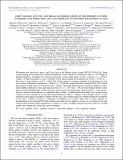| dc.contributor.author | McNamara, Brian R. | |
| dc.contributor.author | Weeren, Reinout J. van | |
| dc.contributor.author | Applegate, Douglas E. | |
| dc.contributor.author | Bayliss, Matthew | |
| dc.contributor.author | Bautz, Marshall W. | |
| dc.contributor.author | Benson, Bradford A. | |
| dc.contributor.author | Carlstrom, John E. | |
| dc.contributor.author | Bleem, Lindsey E. | |
| dc.contributor.author | Chatzikos, Marios | |
| dc.contributor.author | Edge, Alastair C. | |
| dc.contributor.author | Fabian, Andrew C. | |
| dc.contributor.author | Garmire, Gordon P. | |
| dc.contributor.author | Hlavacek-Larrondo, Julie | |
| dc.contributor.author | Jones-Forman, Christine | |
| dc.contributor.author | Mantz, Adam B. | |
| dc.contributor.author | Stalder, Brian | |
| dc.contributor.author | Veilleux, Sylvain | |
| dc.contributor.author | ZuHone, John A. | |
| dc.contributor.author | McDonald, Michael A. | |
| dc.contributor.author | Miller, Eric D | |
| dc.date.accessioned | 2015-11-24T18:26:13Z | |
| dc.date.available | 2015-11-24T18:26:13Z | |
| dc.date.issued | 2015-09 | |
| dc.date.submitted | 2015-05 | |
| dc.identifier.issn | 1538-4357 | |
| dc.identifier.issn | 0004-637X | |
| dc.identifier.uri | http://hdl.handle.net/1721.1/100034 | |
| dc.description.abstract | We present new ultraviolet, optical, and X-ray data on the Phoenix galaxy cluster (SPT-CLJ2344-4243). Deep optical imaging reveals previously undetected filaments of star formation, extending to radii of ~50–100 kpc in multiple directions. Combined UV-optical spectroscopy of the central galaxy reveals a massive (2 × 10[superscript 9] M[subscript ⊙]), young (~4.5 Myr) population of stars, consistent with a time-averaged star formation rate of 610 ± 50 M[subscript ⊙] yr[superscript −1]. We report a strong detection of O vi λλ1032,1038, which appears to originate primarily in shock-heated gas, but may contain a substantial contribution (>1000 M[subscript ⊙] yr[superscript −1]) from the cooling intracluster medium (ICM). We confirm the presence of deep X-ray cavities in the inner ~10 kpc, which are among the most extreme examples of radio-mode feedback detected to date, implying jet powers of 2–7 × 10[superscript 45] erg s[superscript −1]. We provide evidence that the active galactic nucleus inflating these cavities may have only recently transitioned from "quasar-mode" to "radio-mode," and may currently be insufficient to completely offset cooling. A model-subtracted residual X-ray image reveals evidence for prior episodes of strong radio-mode feedback at radii of ~100 kpc, with extended "ghost" cavities indicating a prior epoch of feedback roughly 100 Myr ago. This residual image also exhibits significant asymmetry in the inner ~200 kpc (0.15R[subscript 500]), reminiscent of infalling cool clouds, either due to minor mergers or fragmentation of the cooling ICM. Taken together, these data reveal a rapidly evolving cool core which is rich with structure (both spatially and in temperature), is subject to a variety of highly energetic processes, and yet is cooling rapidly and forming stars along thin, narrow filaments. | en_US |
| dc.description.sponsorship | United States. National Aeronautics and Space Administration (Contract HST-GO-13456.002A (Hubble)) | en_US |
| dc.description.sponsorship | United States. National Aeronautics and Space Administration (Contract GO4-15122A (Chandra)) | en_US |
| dc.description.sponsorship | United States. National Aeronautics and Space Administration (Hubble Fellowship Grant HST-HF51308.01) | en_US |
| dc.language.iso | en_US | |
| dc.publisher | IOP Publishing | en_US |
| dc.relation.isversionof | http://dx.doi.org/10.1088/0004-637X/811/2/111 | en_US |
| dc.rights | Article is made available in accordance with the publisher's policy and may be subject to US copyright law. Please refer to the publisher's site for terms of use. | en_US |
| dc.source | IOP Publishing | en_US |
| dc.title | DEEP CHANDRA , HST-COS, AND MEGACAM OBSERVATIONS OF THE PHOENIX CLUSTER: EXTREME STAR FORMATION AND AGN FEEDBACK ON HUNDRED KILOPARSEC SCALES | en_US |
| dc.type | Article | en_US |
| dc.identifier.citation | McDonald, Michael, Brian R. McNamara, Reinout J. van Weeren, Douglas E. Applegate, Matthew Bayliss, Marshall W. Bautz, Bradford A. Benson, et al. “DEEP CHANDRA , HST-COS, AND MEGACAM OBSERVATIONS OF THE PHOENIX CLUSTER: EXTREME STAR FORMATION AND AGN FEEDBACK ON HUNDRED KILOPARSEC SCALES.” The Astrophysical Journal 811, no. 2 (September 28, 2015): 111. © 2015 The American Astronomical Society | en_US |
| dc.contributor.department | Massachusetts Institute of Technology. Department of Physics | en_US |
| dc.contributor.department | MIT Kavli Institute for Astrophysics and Space Research | en_US |
| dc.contributor.mitauthor | McDonald, Michael A. | en_US |
| dc.contributor.mitauthor | Bautz, Marshall W. | en_US |
| dc.contributor.mitauthor | Miller, Eric D. | en_US |
| dc.contributor.mitauthor | ZuHone, John A. | en_US |
| dc.relation.journal | The Astrophysical Journal | en_US |
| dc.eprint.version | Final published version | en_US |
| dc.type.uri | http://purl.org/eprint/type/JournalArticle | en_US |
| eprint.status | http://purl.org/eprint/status/PeerReviewed | en_US |
| dspace.orderedauthors | McDonald, Michael; McNamara, Brian R.; Weeren, Reinout J. van; Applegate, Douglas E.; Bayliss, Matthew; Bautz, Marshall W.; Benson, Bradford A.; Carlstrom, John E.; Bleem, Lindsey E.; Chatzikos, Marios; Edge, Alastair C.; Fabian, Andrew C.; Garmire, Gordon P.; Hlavacek-Larrondo, Julie; Jones-Forman, Christine; Mantz, Adam B.; Miller, Eric D.; Stalder, Brian; Veilleux, Sylvain; ZuHone, John A. | en_US |
| dc.identifier.orcid | https://orcid.org/0000-0002-0883-9383 | |
| dc.identifier.orcid | https://orcid.org/0000-0002-1379-4482 | |
| mit.license | PUBLISHER_POLICY | en_US |
| mit.metadata.status | Complete | |
